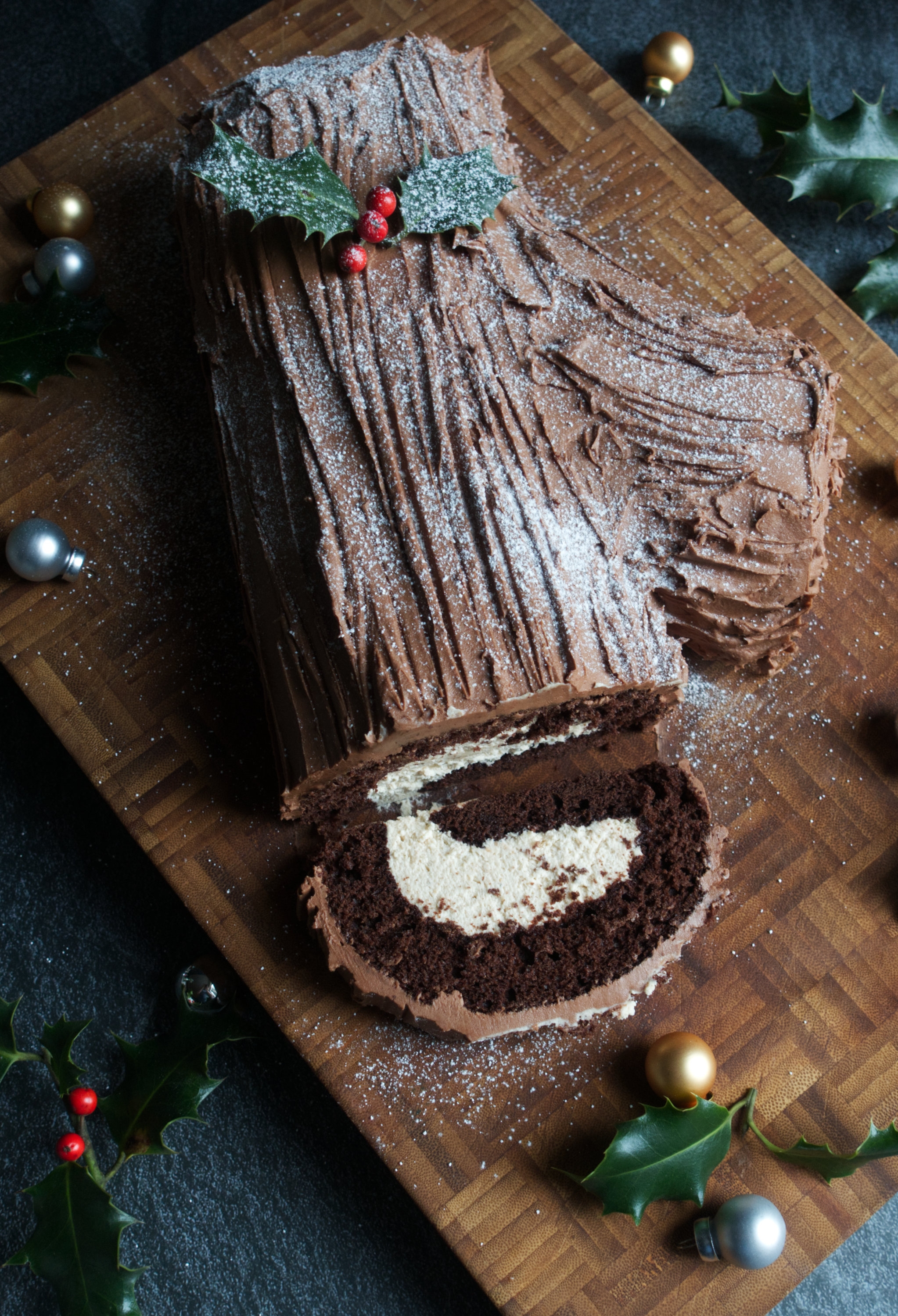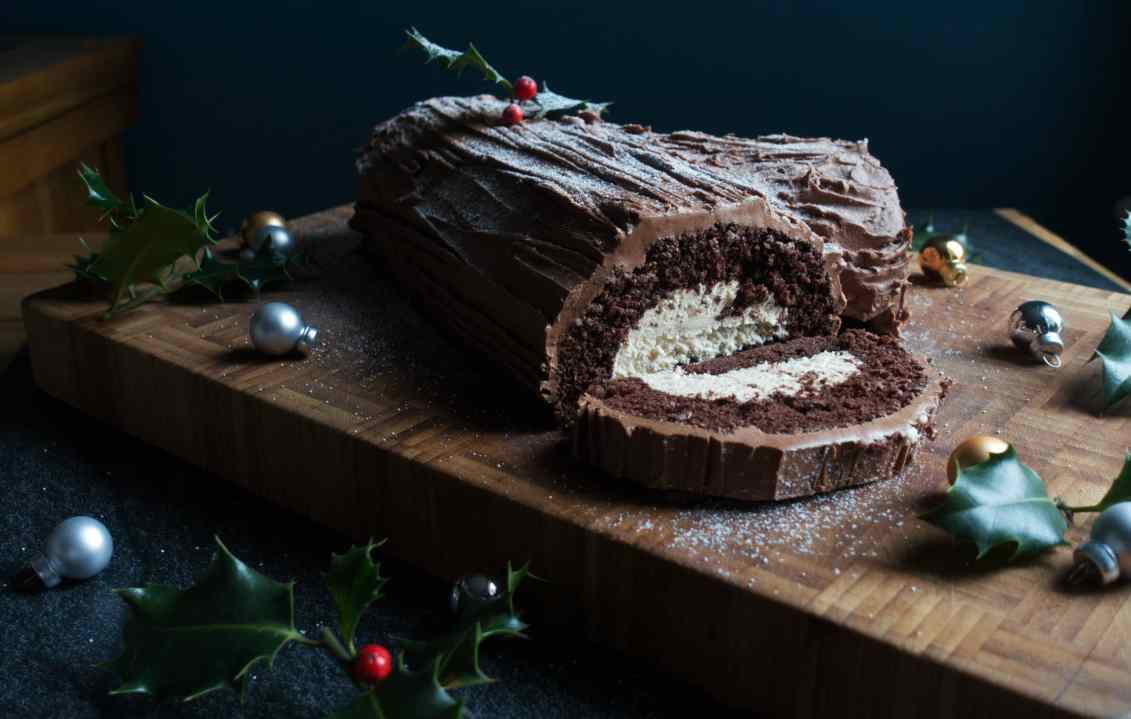I watch a lot of Great British Bake Off. I’d like to say it comes with the baking territory, but the truth is, I’m simply hooked. I love all of it: the triumphs, the disasters, the crap jokes, the obscure technicals, all of it. My dedication to GBBO has taught me a couple of things: the Hollywood handshake has been so devalued in recent years as to be completely worthless; it’s probably worth breaking down and having a cry over your macarons just to get a hug from Noel Fielding, and swiss rolls are a bloody nightmare. They’re fiddly: they require whisking the yolks and whites separately, and then gingerly folding them together, before turning the whole thing out onto a tea-towel, doing some kind of weird pre-roll to set the shape, and then rolling again. And then, after you’ve put all that care and elbow grease into them, they crack on you.
A yule log (sometimes called a bûche de Noël) is a roulade: a light sponge, normally plain vanilla sponge, baked in a Swiss roll tin, and then rolled with a sweetened cream filling, decorated with chocolate ganache or buttercream to resemble a fallen log. It is, basically, a chocolate-covered swiss roll.
So why am I suggesting that you put yourself through this pain? Well, I’m not, I’m going to give you a few cheats that will not only make the whole process significantly easier, but also, I think, produce a far superior cake. When I came across a method for an old-fashioned ‘jelly roll’ from Queen of American technical baking, Stella Parks, that promised an end to these fiddly processes, I was sold. Here, she did away with a lot of the usual swiss roll faff, by using a bunch of easier techniques, which I’ve applied to the chocolate yule log.
First of all, there’s no need to fold whites into yolks; here whole eggs are whisked. Instead of pre-rolling the sponge, as soon as the tin comes out of the oven it is tightly covered with tin foil: this keeps it flexible when it cools, preventing cracks. Traditionally, the sponge is genoise, and the only raising agent is elbow grease, but as far as I’m concerned, there is little virtue in bakery martyrdom: if you can use self-raising flour to create a risen and well-textured sponge, why eschew them? So here, we use self-raising flour to ensure the rise.
I’ve chosen to fold chestnut purée through the whipped cream filling, for a sweet, earthy, festive flavour, but if you can’t get hold of it, substitutions are given below for a simple muscovado alternative. The chocolate buttercream icing is made in the food processor, and embarrassingly easy – leaving you more time to exercise your creative urges and turn this sponge cake into a particularly delicious piece of forest floor.

Yule Log
Makes: 8-10 slices
Takes: 20 minutes, plus cooling
Bakes: 10-15 minutes
For the sponge
4 eggs
100g caster sugar
100g light brown sugar
½ teaspoon fine salt
85g melted butter
75g self raising flour
50g cocoa powder
For the filling
250 ml double cream
250g chestnut puree (optional; if not using substitute for 200ml more cream and 100g light brown sugar)
For the icing
175g dark chocolate, melted and cooled to room temperature
250g icing sugar
225g soft butter
30ml espresso (optional)
- Preheat the oven to 180°C and grease and line a 20x30cm swissroll pan with greaseproof paper. Place the eggs, sugar and salt in the bowl of a stand mixer, fitted with a whisk attachment. Whisk on a medium-low speed for about three minutes, until the sugar has dissolved.
- Increase the speed to medium-high and whisk until the mixture is pale, doubled in volume and, when the whisk is lifted away, will mound briefly on top of itself – this will take about ten minutes. Sift the cocoa powder and self-raising flour together into a separate bowl.
- Pour in the melted butter, then reduce the whisk speed to low and add the flour and cocoa powder all in one go. As soon as the flour is incorporated, turn the mixture off and scrape the mixture from the top to bottom using a flexible spatula.
- Scrape into your prepared tin and bake for 12 minutes, or until the sponge is risen and golden, but still soft enough to take the imprint of a finger when prodded. Immediately cover the tray tightly with two pieces of aluminium foil (try to keep this taut and avoid touching the surface of the sponge, but don’t worry too much). Leave the covered sponge to cool until the pan is cool (but not cold) to the touch.
- Carefully but quickly lift the cake on its parchment onto a flat surface. Whisk the cream in a large, clean bowl until it reaches medium peaks, then fold through the chestnut purée. If omitting the chestnut, add the sugar when you first begin whisking the cream. Spread the cream across the sponge.
- Lift the edge of the parchment along the widest side of the sponge, and gently fold and press, using the baking parchment to lift and maneuver: it will peel away as the sponge rolls. When completely rolled, use a large spatula or cake-lifter to transfer the rolled sponge to your serving platter, seam-down.
- Now make the icing: blitz the icing sugar in a food processor, then add the butter, followed by the melted chocolate, until smooth and combined. If using the 30ml espresso, finally add this and pulse into the mixture.
- Cut the end of the rolled sponge off on the diagonal: this will become your branch, the main sponge roll will be the log. Place this offcut at an angle tightly alongside the rest of the sponge. Smooth the icing across the outside of the rolled sponges, covering any join between offcut and main sponge, and ensuring that the ends are also iced. Use a fork to create whorls and grooves in the icing to imitate bark. Dust with icing sugar and serve.







Comments